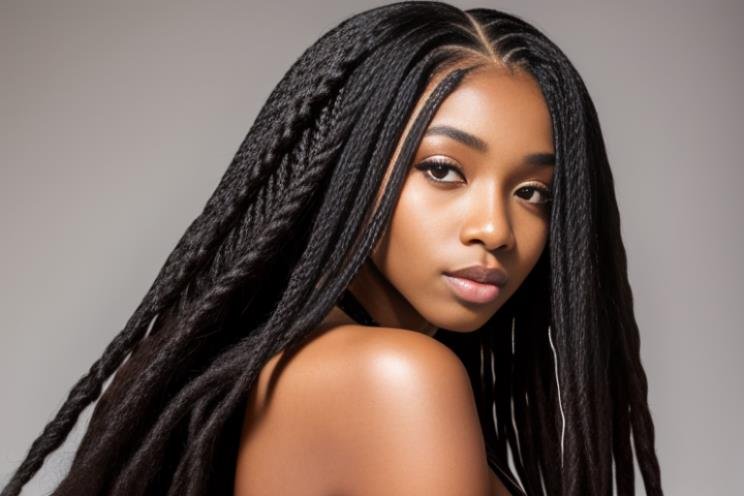Beauty is something we aspire to and pursue in our daily life. But sometimes inappropriate actions can backfire. My favorite effortless approach to vary up my hairstyle is to wear wigs. But if you don’t take care, wearing them for an extended period of time might harm and dry out your natural hair. In order to protect my natural hair while enjoying braided wigs, I’ve learnt several useful tips over the years of wearing wigs.
Table of Contents
Properly prepare
I make sure to thoroughly wash and condition my hair before putting on any wigs. Synthetic and wigs may be more likely to fall off due to the oils and deposits that gradually develop on your scalp. After a thorough wash, my scalp feels revitalized, which makes my wigs fit more comfortably. It’s also a good idea to detangle your hair gently with a wide-tooth comb or your fingers to prevent any breakage or damage.
Rely on a soft material inside
A strip of elastic is sewed into the interior of the majority of my Knotless Twist. But with time, that band can exert too much pressure on my hairline and shatter it. To reduce friction, I replace it with a supple material like silk, satin, or velvet. I wrap all of the inside edges with a gentle cloth because my braids feel abrasive even with the elastic inserted through lace wig caps.

Reliable, but not overly tight
When it comes to finding secure and comfortable wigs, I prefer knotless braids styles. The best option is not to cinch drawstrings or elastic bands as tightly as possible. The key is to fit it just snugly enough, then for further security, use bobby pins or wig grip adhesive. Some of my own hair can peek through my crochet braids and lace wigs, blending in more organically. A tight fit restricts blood flow to the hair follicles, which over time might harm them.
Tender treatment
Maintaining a clean, moisturized, and healthy scalp is another crucial piece of advice for keeping your natural hair safe while wearing braided wigs. This calls for routine scalp washing—at least once per week, but ideally twice or three times. Use a gentle, sulfate-free shampoo made for scalps with dry or sensitive skin when washing. To assist break up oil, sweat, and debris accumulation, massage the shampoo into your scalp for two to three minutes in circular motions.

You must carefully condition your scalp after shampooing in order to maintain its moisture. Use a conditioner designed especially for dry, itchy, or irritated scalps. Allow the conditioner to stay on your scalp for three to five minutes to help hydrate and calm the scalp. Applying gentle pressure with your fingertips, massage the conditioner into the scalp, paying special attention to any areas that are prone to dryness or flakiness. Oils like jojoba, argan and coconut hydrate and moisturize the scalp, helping to battle irritation and flakiness. Massage 2-3 drops of the oil into your scalp, focusing on your hairline and crown. Leave the oil on overnight and wash out in the morning. This regimen will keep your scalp clean, hydrated and healthy to promote hair growth underneath your wig.
Provide frequent breaths
I make an effort to remove my wigs for a full day or two every week, even when I’m loving a specific style. My natural hair can now acquire some moisture and my scalp can “breathe” again. My strands can become weaker and drier when I wear a wig everyday for months at a time because of the lack of exposure to air and the moisture from taking showers. Taking pauses from time to time stimulates the scalp and keeps my hair healthy there.

Gently put on your wig
When I first started using Criss Cross Braids and braided wigs regularly, I noticed excess shedding and tangling in my own hair over time. I now adopt new wig styles progressively, starting with small knotless braids. As my hair becomes used to the change, I gradually increase my use of them daily from a few days a week. In order to prevent damage from the start, moving slowly helps reduce tension on my strands.
Healthy life
Finally, it’s important to remember that wearing a braided wig is just one part of your natural hair care routine. To keep your hair healthy and thriving, you should also make sure to eat a healthy diet, drink plenty of water, and protect your hair from heat and environmental damage. This means avoiding excessive heat styling, wearing protective styles when necessary, and using a scarf or hat to protect your hair from the sun and wind.
Conclusion
In conclusion, wearing braided wigs can be a great way to protect your natural hair while also enjoying the versatility and convenience that wigs offer. I’ve discovered a happy medium where my natural hair stays healthy underneath even my favorite wig designs by keeping these wig maintenance suggestions in mind. I hope they’ll aid in your hair protection as you rock those braided wigs in your own special style!










